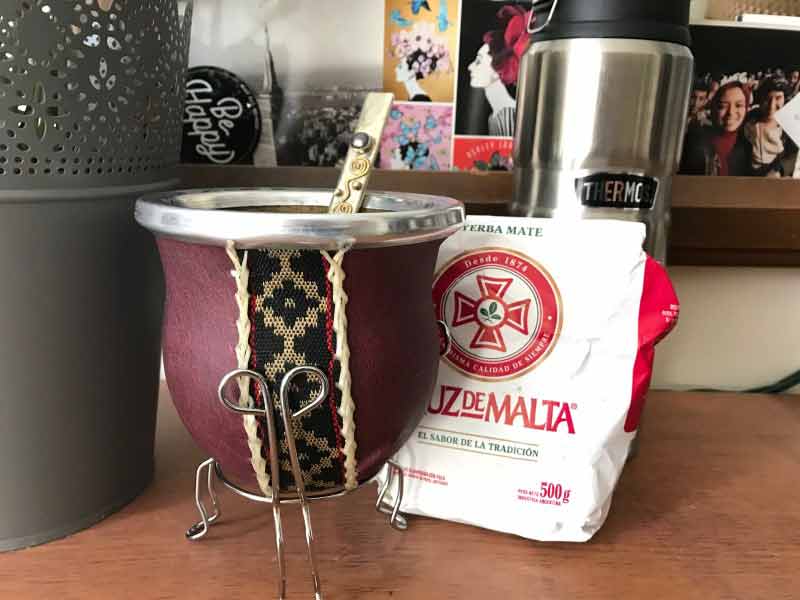
By Claudia Crook
Travel Writer28 Sep 2018 - 5 Minute Read
I first saw it from a distance, held by a young rafting guide on the deck of a lodge overlooking the Mendoza River. Then, it was passed from husband to wife on a jostling bus as we climbed through the technicolor Quebrada de Humahuaca, not far from the Bolivian border. From the base of Mt. Fitzroy in Patagonia to Buenos Aires’ Plaza Dorrego, it was everywhere, but always just out of reach: the Holy Grail of Argentinian inclusion, the Guarani moon goddess Yari’s ultimate symbol of friendship and hospitality, the Drink of a Nation. Or, put simply, yerba mate.
Soon-to-be travelers to Argentina are repeatedly told they must try “mate” (MAH-tay). The word refers both to the drink itself and the vessel in which is it served: you drink mate from a mate. Typically a hollow, dried gourd, a mate is filled with leaves of a naturally caffeinated relative of the holly plant called yerba mate, over which hot – not boiling – water is poured, and then sipped through a metal straw called a bombilla (bom-BEE-sha). This apparently happens all day, everyday, all over Argentina.
Mate is a national icon, as much as Lionel Messi or Pope Francis; indeed, after five minutes in the kiosks of Ezeiza Airport I’d seen mate-shaped keychains embossed with the faces of both. When discussing mate outside of Argentina, the initiated often speak of it with a wistful fondness, as if to say, “Oh yes, my old friend…” And to read about it gives the impression that, in many ways, mate is Argentina. A bitter beverage often disliked by extranjeros, mate is a cultural unifier in a country with widely disparate native and immigrant heritages, and drinking it has become part of the national identity. The implied message is: if you don’t like mate, you don’t like Argentina. But if you do, you are one of us.
I soon learned, however, that mate is not typically available in restaurants; rather, it is consumed socially in Argentine homes. It cannot be purchased by the cup, but must be offered. With this added element of exclusivity, whether or not I would try mate quickly became the litmus test of how well and thoroughly I had explored the country.


I imagined the process to be somewhat like a Chinese finger trap: relax, and you’ll achieve your goal. But my spidey senses tingled every time I saw it in the crowd. Would a Porteño bunkmate in this hostel have some? Would my broken but well-intentioned Spanish charm an Argentinian couple on this mountain tour enough for them to offer me a sip on our bus ride back to town?
I visited the vineyards of Mendoza to taste world-famous Malbecs and Torrontes wines. I drank Quilmes beer with my empanadas and Fernet con Coca while listening to folklórica at a peña. But mate remained a mystery.
I came close in Salta. There were loose plans to join the Argentinian friend of an English friend for mate in the central Plaza 9 de Julio on the eve of 25 de Mayo. I circled the plaza as I waited for the call, weaving through uniformed mounted cavalry and a marching band preparing for Independence Day festivities (these were accompanied by fiesta-style protests of equal patriotism and fervor). But, alas, my would-be fixer did not have mate. He had coca leaves and particularly low-grade hash – neither of which was the yerba I yearned for.

By the time I returned to Buenos Aires, I hadn’t resigned myself to the fact that I might not be offered mate so much as forgotten it. With all I had experienced in the past month, I felt little was missing. Coming back to the capital was a bit like coming home. The streets were familiar; my Spanish was strong; my pesos were well-worn.
Then, as I wandered a craft fair in the streets of San Telmo, I finally heard the words I’d been waiting to hear: “Querés un mate?”
I looked up from the bombilla I was admiring – flat, silver, with spiraling gold filigree, set with a single black pearl at the mouth – to see Walter, the silversmith, holding out a small round mate with a spider-crested bombilla. Walter was tall, with considerable heft – his scraggly salt and pepper beard was accented with multiple facial piercings. He could easily have been intimidating, but his jovial spirit and relaxed manner gave him the air of a grunge-punk Ghost of Christmas Present. Without thinking, I accepted, as he had accepted me.
I sipped, careful to balance a month’s worth of anticipation with the knowledge that such excitement, left unchecked, would surely result in a burnt tongue. It tasted bitter, earthy, reminiscent of the scent of hay, and the energizing effect of the brew was immediate, but I left with a buzz from more than just the caffeine. I thanked Walter, signaling that I’d drunk my fill, and drifted back to the crowds of the fair – search complete, finger trap released, country explored.
I now own a full mate set of my own: a leather-bound, wide-mouthed calabaza with a strip of woven canvas and a silver stand, complete with the bombilla of Walter’s making. I fill it with my own Cruz de Malta yerba and pour from my own thermos. And I’ll be the first to tell you: if you’re ever in Argentina, you must try mate.

Discover similar stories in
connection
Travel Writer
Claudia is lifelong traveler and writer, combining the two first in a high school travel blog during an internship in London, then most recently in Argentina as a winner of the 2018 World Nomads Travel Writing Scholarship.




No Comments